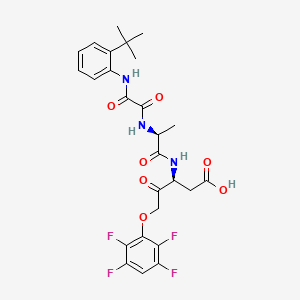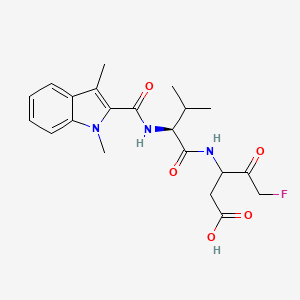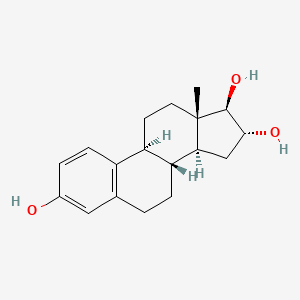
Lenalidomida
Descripción general
Descripción
Mecanismo De Acción
Lenalidomida ejerce sus efectos a través de múltiples mecanismos:
Aplicaciones Científicas De Investigación
Lenalidomida tiene una amplia gama de aplicaciones de investigación científica:
Análisis Bioquímico
Biochemical Properties
Lenalidomide interacts with various enzymes, proteins, and other biomolecules. It binds to an E3 ubiquitin ligase complex protein, cereblon, modulating its downstream effects . This interaction is associated with the antitumor and immunomodulatory properties of lenalidomide .
Cellular Effects
Lenalidomide has profound effects on various types of cells and cellular processes. It triggers T-cell effector functions in vivo in patients with follicular lymphoma . It induces early T-cell activation and reprogramming, and restores long-term immune synapse formation . Lenalidomide also promotes the inhibition of basic fibroblast growth (bFBG) and vascular endothelial growth factor (VEGF) .
Molecular Mechanism
Lenalidomide exerts its effects at the molecular level through various mechanisms. It acts by a novel drug mechanism—modulation of the substrate specificity of the CRL4 CRBN E3 ubiquitin ligase . In multiple myeloma, lenalidomide induces the ubiquitination of IKZF1 and IKZF3 by CRL4 CRBN . Subsequent proteasomal degradation of these transcription factors kills multiple myeloma cells .
Temporal Effects in Laboratory Settings
Lenalidomide has shown progression-free (PFS) and overall survival (OS) benefit in clinical trials . It is the recommended standard of care in patients with newly diagnosed multiple myeloma (MM) after high-dose melphalan and autologous stem cell transplantation (HDM-ASCT) .
Dosage Effects in Animal Models
In mice, lenalidomide is rapidly and highly absorbed (>90% of dose) under fasting conditions . The increase in AUC and C max is dose proportional, and interindividual variability in plasma exposure is low to moderate . Lenalidomide distributes into semen but is undetectable 3 days after stopping treatment .
Metabolic Pathways
Biotransformation of lenalidomide in humans includes chiral inversion, trivial hydroxylation, and slow non-enzymatic hydrolysis . Approximately 82% of an oral dose is excreted as lenalidomide in urine within 24 hours .
Transport and Distribution
Lenalidomide is transported and distributed within cells and tissues. It is a weak substrate of P-glycoprotein (P-gp) in vitro . Lenalidomide does not have clinically significant pharmacokinetic interactions with P-gp substrates/inhibitors in controlled studies .
Subcellular Localization
It is known that lenalidomide binds to an E3 ubiquitin ligase complex protein, cereblon, modulating its downstream effects . This suggests that lenalidomide may be localized in the cytoplasm where the ubiquitin-proteasome system is active.
Métodos De Preparación
Rutas de Síntesis y Condiciones de Reacción: La síntesis de lenalidomida típicamente implica la ciclación del 2-(bromometil)-3-nitrobenzoato de metilo con clorhidrato de 3-aminopiperidina-2,6-diona para formar el precursor nitro. Este precursor se somete luego a hidrogenación utilizando paladio sobre carbón como catalizador para producir this compound . Las condiciones de reacción incluyen mantener una presión de hidrógeno de 0.3-0.8 Mpa y una temperatura de 80°C .
Métodos de Producción Industrial: La producción industrial de this compound sigue rutas sintéticas similares pero a una escala mayor. El proceso implica medidas estrictas de control de calidad para garantizar la pureza y la eficacia del producto final. Se emplean técnicas cromatográficas avanzadas, como la cromatografía líquida de alto rendimiento, para separar y purificar la this compound de las sustancias relacionadas .
Análisis De Reacciones Químicas
Tipos de Reacciones: Lenalidomida experimenta varias reacciones químicas, incluyendo:
Oxidación: this compound puede oxidarse para formar 5-hidroxithis compound.
Reducción: El precursor nitro de this compound se reduce para formar el producto final.
Sustitución: this compound puede sufrir reacciones de sustitución, particularmente en el grupo amino.
Reactivos y Condiciones Comunes:
Oxidación: Reactivos como el peróxido de hidrógeno o el permanganato de potasio pueden usarse bajo condiciones controladas.
Reducción: El paladio sobre carbón se usa comúnmente como catalizador en reacciones de hidrogenación.
Sustitución: Se pueden emplear varios nucleófilos dependiendo del producto de sustitución deseado.
Productos Principales:
Oxidación: 5-hidroxithis compound
Reducción: this compound a partir de su precursor nitro
Sustitución: Varios derivados sustituidos de this compound
Comparación Con Compuestos Similares
Lenalidomida se compara a menudo con otros fármacos inmunomoduladores como la talidomida y la pomalidomida:
Talidomida: this compound es un análogo más potente con menos efectos adversos.
Pomalidomida: Pomalidomida es otro derivado con aplicaciones terapéuticas similares pero difiere en su potencia y perfil de efectos secundarios.
Compuestos Similares:
- Talidomida
- Pomalidomida
- Ciclofosfamida (utilizada en terapias combinadas)
Las propiedades únicas de this compound, como su mayor potencia y menor toxicidad en comparación con la talidomida, la convierten en un valioso agente terapéutico en el tratamiento de malignidades hematológicas .
Propiedades
IUPAC Name |
3-(7-amino-3-oxo-1H-isoindol-2-yl)piperidine-2,6-dione | |
|---|---|---|
| Source | PubChem | |
| URL | https://pubchem.ncbi.nlm.nih.gov | |
| Description | Data deposited in or computed by PubChem | |
InChI |
InChI=1S/C13H13N3O3/c14-9-3-1-2-7-8(9)6-16(13(7)19)10-4-5-11(17)15-12(10)18/h1-3,10H,4-6,14H2,(H,15,17,18) | |
| Source | PubChem | |
| URL | https://pubchem.ncbi.nlm.nih.gov | |
| Description | Data deposited in or computed by PubChem | |
InChI Key |
GOTYRUGSSMKFNF-UHFFFAOYSA-N | |
| Source | PubChem | |
| URL | https://pubchem.ncbi.nlm.nih.gov | |
| Description | Data deposited in or computed by PubChem | |
Canonical SMILES |
C1CC(=O)NC(=O)C1N2CC3=C(C2=O)C=CC=C3N | |
| Source | PubChem | |
| URL | https://pubchem.ncbi.nlm.nih.gov | |
| Description | Data deposited in or computed by PubChem | |
Molecular Formula |
C13H13N3O3 | |
| Source | PubChem | |
| URL | https://pubchem.ncbi.nlm.nih.gov | |
| Description | Data deposited in or computed by PubChem | |
DSSTOX Substance ID |
DTXSID8046664 | |
| Record name | Lenalidomide | |
| Source | EPA DSSTox | |
| URL | https://comptox.epa.gov/dashboard/DTXSID8046664 | |
| Description | DSSTox provides a high quality public chemistry resource for supporting improved predictive toxicology. | |
Molecular Weight |
259.26 g/mol | |
| Source | PubChem | |
| URL | https://pubchem.ncbi.nlm.nih.gov | |
| Description | Data deposited in or computed by PubChem | |
Physical Description |
Solid | |
| Record name | Lenalidomide | |
| Source | Human Metabolome Database (HMDB) | |
| URL | http://www.hmdb.ca/metabolites/HMDB0014623 | |
| Description | The Human Metabolome Database (HMDB) is a freely available electronic database containing detailed information about small molecule metabolites found in the human body. | |
| Explanation | HMDB is offered to the public as a freely available resource. Use and re-distribution of the data, in whole or in part, for commercial purposes requires explicit permission of the authors and explicit acknowledgment of the source material (HMDB) and the original publication (see the HMDB citing page). We ask that users who download significant portions of the database cite the HMDB paper in any resulting publications. | |
Solubility |
Soluble in organic solvent/water mixtures, and buffered aqueous solvents. Lenalidomide is more soluble in organic solvents and low pH solutions. Solubility was significantly lower in less acidic buffers, ranging from about 0.4 to 0.5 mg/mL., Soluble in organic solvent/water mixtures and buffered aqueous solutions. ... more soluble in organic solvents and low pH solutions. Solubility was ... lower in less acidic buffers, ranging from 0.4 to 0.5 mg/mL, 2.33e+00 g/L | |
| Record name | Lenalidomide | |
| Source | DrugBank | |
| URL | https://www.drugbank.ca/drugs/DB00480 | |
| Description | The DrugBank database is a unique bioinformatics and cheminformatics resource that combines detailed drug (i.e. chemical, pharmacological and pharmaceutical) data with comprehensive drug target (i.e. sequence, structure, and pathway) information. | |
| Explanation | Creative Common's Attribution-NonCommercial 4.0 International License (http://creativecommons.org/licenses/by-nc/4.0/legalcode) | |
| Record name | Lenalidomide | |
| Source | Hazardous Substances Data Bank (HSDB) | |
| URL | https://pubchem.ncbi.nlm.nih.gov/source/hsdb/8220 | |
| Description | The Hazardous Substances Data Bank (HSDB) is a toxicology database that focuses on the toxicology of potentially hazardous chemicals. It provides information on human exposure, industrial hygiene, emergency handling procedures, environmental fate, regulatory requirements, nanomaterials, and related areas. The information in HSDB has been assessed by a Scientific Review Panel. | |
| Record name | Lenalidomide | |
| Source | Human Metabolome Database (HMDB) | |
| URL | http://www.hmdb.ca/metabolites/HMDB0014623 | |
| Description | The Human Metabolome Database (HMDB) is a freely available electronic database containing detailed information about small molecule metabolites found in the human body. | |
| Explanation | HMDB is offered to the public as a freely available resource. Use and re-distribution of the data, in whole or in part, for commercial purposes requires explicit permission of the authors and explicit acknowledgment of the source material (HMDB) and the original publication (see the HMDB citing page). We ask that users who download significant portions of the database cite the HMDB paper in any resulting publications. | |
Mechanism of Action |
Lenalidomide is a drug with multiple mechanisms of action. Lenalidomide exerts immunomodulating effects by altering cytokine production, regulating T cell co-stimulation, and enhancing the NK cell-mediated cytotoxicity. Lenalidomide directly inhibits the cullin ring E3 ubiquitin ligase complex: upon binding to cereblon, a substrate adaptor of the complex, lenalidomide modulates substrate specificity of the complex to recruit substrate proteins of the ligase, including Ikaros (IKZF1), Aiolos (IKZF3), and CK1α. These substrates are then tagged for ubiquitination and subsequent proteasomal degradation. IKZF1 and IKZF3 are B-cell transcription factors that are essential for B-cell differentiation and survival of malignant cells. IKZF3 also regulates the expression of interferon regulatory factor 4 (IRF4), which is a transcription factor that regulates the aberrant myeloma-specific gene. The immunomodulatory actions of lenalidomide can be partly explained by the degradation of IKZF3, since it is a repressor of the interleukin 2 gene (IL2): as lenalidomide decreases the level of IKZF3, the production of IL-2 increases, thereby increasing the proliferation of natural killer (NK), NKT cells, and CD4+ T cells. Lenalidomide inhibits the production of pro-inflammatory cytokines TNF-α, IL-1, IL-6, and IL-12, while elevating the production of anti-inflammatory cytokine IL-10. Lenalidomide acts as a T-cell co-stimulatory molecule that promotes CD3 T-cell proliferation and increases the production of IL-2 and IFN-γ in T lymphocytes, which enhances NK cell cytotoxicity and ADCC. It inhibits the expression and function of T-regulatory cells, which are often overabundant in some hematological malignancies. Lenalidomide directly exerts antitumour effects by inhibiting the proliferation and inducing apoptosis of tumour cells. Lenalidomide triggers the activation of pro-apoptotic caspase-8, enhances tumour cell sensitivity to FAS-induced apoptosis, and downregulates NF-κB, an anti-apoptotic protein. Independent of its immunomodulatory effects, lenalidomide mediates anti-angiogenic effects by inhibiting angiogenic growth factors released by tumour cells, such as vascular endothelial growth factor (VEGF), basic fibroblastic-growth factor (BFGF), and hepatocyte-growth factor. _In vitro_, lenalidomide inhibits cell adhesion molecules such as ICAM-1, LFA-1, β2 and β3 integrins, as well as gap-junction function, thereby preventing metastasis of malignant cells., Multiple myeloma is a B-cell malignancy characterized by an excess of monotypic plasma cells in the bone marrow. The molecular mechanisms that are involved in disease progression depend on the interaction between the multiple myeloma cells and the bone microenvironment. Because these mechanisms have been well characterized, it is possible to develop regimens that are more specific to pathways involved in the pathogenesis of multiple myeloma than is typical for conventional chemotherapy in disease management. Thalidomide and immunomodulatory drugs (IMiDs) have now been shown to block several pathways important for disease progression in multiple myeloma. First established as agents with antiangiogenic properties, thalidomide and IMiDs inhibit the production of interleukin (IL)-6, which is a growth factor for the proliferation of myeloma cells. In addition, they activate apoptotic pathways through caspase 8-mediated cell death. At the mitochondrial level, they are responsible for c-jun terminal kinase (JNK)-dependent release of cytochrome-c and Smac into the cytosol of cells, where they regulate the activity of molecules that affect apoptosis. By activating T cells to produce IL-2, thalidomide and IMiDs alter natural killer (NK) cell numbers and function, thus augmenting the activity of NK-dependent cytotoxicity. Data delineating these events have been derived from experiments done in resistant and sensitive multiple myeloma cell lines. Although thalidomide and IMiDs demonstrate similar biologic activities, IMiDs are more potent than thalidomide and achieve responses at lower doses. Lenalidomide, a thalidomide derivative, has also been shown to have a different toxicity profile. Our understanding of the mechanism of action of these agents has provided a platform for exciting clinical trials evaluating combinations of thalidomide and lenalidomide with both conventional chemotherapy and newer targeted agents., Lenalidomide is an analogue of thalidomide with immunomodulatory, antiangiogenic, and antineoplastic properties. Lenalidomide inhibits proliferation and induces apoptosis of certain hematopoietic tumor cells including multiple myeloma, mantle cell lymphoma, and del (5q) myelodysplastic syndromes in vitro. Lenalidomide causes a delay in tumor growth in some in vivo nonclinical hematopoietic tumor models including multiple myeloma. Immunomodulatory properties of lenalidomide include activation of T cells and natural killer (NK) cells, increased numbers of NKT cells, and inhibition of pro-inflammatory cytokines (e.g., TNF-alpha and IL-6) by monocytes. In multiple myeloma cells, the combination of lenalidomide and dexamethasone synergizes the inhibition of cell proliferation and the induction of apoptosis., Although several mechanisms have been proposed to explain the activity of thalidomide, lenalidomide and pomalidomide in multiple myeloma (MM), including demonstrable anti-angiogenic, anti-proliferative and immunomodulatory effects, the precise cellular targets and molecular mechanisms have only recently become clear. A landmark study recently identified cereblon (CRBN) as a primary target of thalidomide teratogenicity. Subsequently it was demonstrated that CRBN is also required for the anti-myeloma activity of thalidomide and related drugs, the so-called immune-modulatory drugs (IMiDs). Low CRBN expression was found to correlate with drug resistance in MM cell lines and primary MM cells. One of the downstream targets of CRBN identified is interferon regulatory factor 4 (IRF4), which is critical for myeloma cell survival and is down-regulated by IMiD treatment. CRBN is also implicated in several effects of IMiDs, such as down-regulation of tumor necrosis factor-alpha (TNF-a) and T cell immunomodulatory activity, demonstrating that the pleotropic actions of the IMiDs are initiated by binding to CRBN. Future dissection of CRBN downstream signaling will help to delineate the underlying mechanisms for IMiD action and eventually lead to development of new drugs with more specific anti-myeloma activities. It may also provide a biomarker to predict IMiD response and resistance., Immunomodulatory drugs lenalidomide and pomalidomide are synthetic compounds derived by modifying the chemical structure of thalidomide to improve its potency and reduce its side effects. Lenalidomide is a 4-amino-glutamyl analogue of thalidomide that lacks the neurologic side effects of sedation and neuropathy and has emerged as a drug with activity against various hematological and solid malignancies. It is approved by FDA for clinical use in myelodysplastic syndromes with deletion of chromosome 5q and multiple myeloma. Lenalidomide has been shown to be an immunomodulator, affecting both cellular and humoral limbs of the immune system. It has also been shown to have anti-angiogenic properties. Newer studies demonstrate its effects on signal transduction that can partly explain its selective efficacy in subsets of MDS. Even though the exact molecular targets of lenalidomide are not well known, its activity across a spectrum of neoplastic conditions highlights the possibility of multiple target sites of action., For more Mechanism of Action (Complete) data for Lenalidomide (7 total), please visit the HSDB record page. | |
| Record name | Lenalidomide | |
| Source | DrugBank | |
| URL | https://www.drugbank.ca/drugs/DB00480 | |
| Description | The DrugBank database is a unique bioinformatics and cheminformatics resource that combines detailed drug (i.e. chemical, pharmacological and pharmaceutical) data with comprehensive drug target (i.e. sequence, structure, and pathway) information. | |
| Explanation | Creative Common's Attribution-NonCommercial 4.0 International License (http://creativecommons.org/licenses/by-nc/4.0/legalcode) | |
| Record name | Lenalidomide | |
| Source | Hazardous Substances Data Bank (HSDB) | |
| URL | https://pubchem.ncbi.nlm.nih.gov/source/hsdb/8220 | |
| Description | The Hazardous Substances Data Bank (HSDB) is a toxicology database that focuses on the toxicology of potentially hazardous chemicals. It provides information on human exposure, industrial hygiene, emergency handling procedures, environmental fate, regulatory requirements, nanomaterials, and related areas. The information in HSDB has been assessed by a Scientific Review Panel. | |
Color/Form |
Off-white to pale-yellow solid powder | |
CAS No. |
191732-72-6 | |
| Record name | Lenalidomide | |
| Source | CAS Common Chemistry | |
| URL | https://commonchemistry.cas.org/detail?cas_rn=191732-72-6 | |
| Description | CAS Common Chemistry is an open community resource for accessing chemical information. Nearly 500,000 chemical substances from CAS REGISTRY cover areas of community interest, including common and frequently regulated chemicals, and those relevant to high school and undergraduate chemistry classes. This chemical information, curated by our expert scientists, is provided in alignment with our mission as a division of the American Chemical Society. | |
| Explanation | The data from CAS Common Chemistry is provided under a CC-BY-NC 4.0 license, unless otherwise stated. | |
| Record name | Lenalidomide [USAN:INN:BAN] | |
| Source | ChemIDplus | |
| URL | https://pubchem.ncbi.nlm.nih.gov/substance/?source=chemidplus&sourceid=0191732726 | |
| Description | ChemIDplus is a free, web search system that provides access to the structure and nomenclature authority files used for the identification of chemical substances cited in National Library of Medicine (NLM) databases, including the TOXNET system. | |
| Record name | Lenalidomide | |
| Source | DrugBank | |
| URL | https://www.drugbank.ca/drugs/DB00480 | |
| Description | The DrugBank database is a unique bioinformatics and cheminformatics resource that combines detailed drug (i.e. chemical, pharmacological and pharmaceutical) data with comprehensive drug target (i.e. sequence, structure, and pathway) information. | |
| Explanation | Creative Common's Attribution-NonCommercial 4.0 International License (http://creativecommons.org/licenses/by-nc/4.0/legalcode) | |
| Record name | Lenalidomide | |
| Source | DTP/NCI | |
| URL | https://dtp.cancer.gov/dtpstandard/servlet/dwindex?searchtype=NSC&outputformat=html&searchlist=747972 | |
| Description | The NCI Development Therapeutics Program (DTP) provides services and resources to the academic and private-sector research communities worldwide to facilitate the discovery and development of new cancer therapeutic agents. | |
| Explanation | Unless otherwise indicated, all text within NCI products is free of copyright and may be reused without our permission. Credit the National Cancer Institute as the source. | |
| Record name | Lenalidomide | |
| Source | EPA DSSTox | |
| URL | https://comptox.epa.gov/dashboard/DTXSID8046664 | |
| Description | DSSTox provides a high quality public chemistry resource for supporting improved predictive toxicology. | |
| Record name | 3-(4-Amino-1-oxo-1,3-dihydro-2H-isoindol-2-yl)piperidine-2,6-dione | |
| Source | European Chemicals Agency (ECHA) | |
| URL | https://echa.europa.eu/information-on-chemicals | |
| Description | The European Chemicals Agency (ECHA) is an agency of the European Union which is the driving force among regulatory authorities in implementing the EU's groundbreaking chemicals legislation for the benefit of human health and the environment as well as for innovation and competitiveness. | |
| Explanation | Use of the information, documents and data from the ECHA website is subject to the terms and conditions of this Legal Notice, and subject to other binding limitations provided for under applicable law, the information, documents and data made available on the ECHA website may be reproduced, distributed and/or used, totally or in part, for non-commercial purposes provided that ECHA is acknowledged as the source: "Source: European Chemicals Agency, http://echa.europa.eu/". Such acknowledgement must be included in each copy of the material. ECHA permits and encourages organisations and individuals to create links to the ECHA website under the following cumulative conditions: Links can only be made to webpages that provide a link to the Legal Notice page. | |
| Record name | LENALIDOMIDE | |
| Source | FDA Global Substance Registration System (GSRS) | |
| URL | https://gsrs.ncats.nih.gov/ginas/app/beta/substances/F0P408N6V4 | |
| Description | The FDA Global Substance Registration System (GSRS) enables the efficient and accurate exchange of information on what substances are in regulated products. Instead of relying on names, which vary across regulatory domains, countries, and regions, the GSRS knowledge base makes it possible for substances to be defined by standardized, scientific descriptions. | |
| Explanation | Unless otherwise noted, the contents of the FDA website (www.fda.gov), both text and graphics, are not copyrighted. They are in the public domain and may be republished, reprinted and otherwise used freely by anyone without the need to obtain permission from FDA. Credit to the U.S. Food and Drug Administration as the source is appreciated but not required. | |
| Record name | Lenalidomide | |
| Source | Hazardous Substances Data Bank (HSDB) | |
| URL | https://pubchem.ncbi.nlm.nih.gov/source/hsdb/8220 | |
| Description | The Hazardous Substances Data Bank (HSDB) is a toxicology database that focuses on the toxicology of potentially hazardous chemicals. It provides information on human exposure, industrial hygiene, emergency handling procedures, environmental fate, regulatory requirements, nanomaterials, and related areas. The information in HSDB has been assessed by a Scientific Review Panel. | |
| Record name | Lenalidomide | |
| Source | Human Metabolome Database (HMDB) | |
| URL | http://www.hmdb.ca/metabolites/HMDB0014623 | |
| Description | The Human Metabolome Database (HMDB) is a freely available electronic database containing detailed information about small molecule metabolites found in the human body. | |
| Explanation | HMDB is offered to the public as a freely available resource. Use and re-distribution of the data, in whole or in part, for commercial purposes requires explicit permission of the authors and explicit acknowledgment of the source material (HMDB) and the original publication (see the HMDB citing page). We ask that users who download significant portions of the database cite the HMDB paper in any resulting publications. | |
Synthesis routes and methods I
Procedure details











Synthesis routes and methods II
Procedure details







Synthesis routes and methods III
Procedure details





Retrosynthesis Analysis
AI-Powered Synthesis Planning: Our tool employs the Template_relevance Pistachio, Template_relevance Bkms_metabolic, Template_relevance Pistachio_ringbreaker, Template_relevance Reaxys, Template_relevance Reaxys_biocatalysis model, leveraging a vast database of chemical reactions to predict feasible synthetic routes.
One-Step Synthesis Focus: Specifically designed for one-step synthesis, it provides concise and direct routes for your target compounds, streamlining the synthesis process.
Accurate Predictions: Utilizing the extensive PISTACHIO, BKMS_METABOLIC, PISTACHIO_RINGBREAKER, REAXYS, REAXYS_BIOCATALYSIS database, our tool offers high-accuracy predictions, reflecting the latest in chemical research and data.
Strategy Settings
| Precursor scoring | Relevance Heuristic |
|---|---|
| Min. plausibility | 0.01 |
| Model | Template_relevance |
| Template Set | Pistachio/Bkms_metabolic/Pistachio_ringbreaker/Reaxys/Reaxys_biocatalysis |
| Top-N result to add to graph | 6 |
Feasible Synthetic Routes
Descargo de responsabilidad e información sobre productos de investigación in vitro
Tenga en cuenta que todos los artículos e información de productos presentados en BenchChem están destinados únicamente con fines informativos. Los productos disponibles para la compra en BenchChem están diseñados específicamente para estudios in vitro, que se realizan fuera de organismos vivos. Los estudios in vitro, derivados del término latino "in vidrio", involucran experimentos realizados en entornos de laboratorio controlados utilizando células o tejidos. Es importante tener en cuenta que estos productos no se clasifican como medicamentos y no han recibido la aprobación de la FDA para la prevención, tratamiento o cura de ninguna condición médica, dolencia o enfermedad. Debemos enfatizar que cualquier forma de introducción corporal de estos productos en humanos o animales está estrictamente prohibida por ley. Es esencial adherirse a estas pautas para garantizar el cumplimiento de los estándares legales y éticos en la investigación y experimentación.
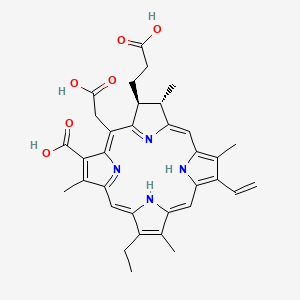
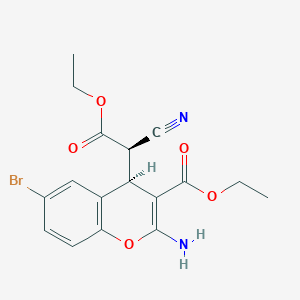
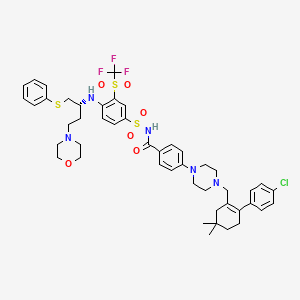
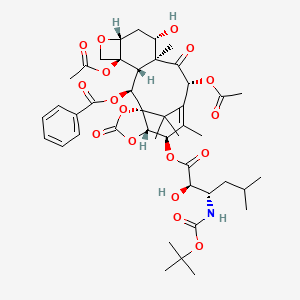
![8-(1-hydroxyethyl)-2-methoxy-3-[(4-methoxyphenyl)methoxy]benzo[c]chromen-6-one](/img/structure/B1683854.png)
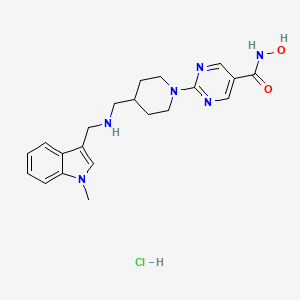
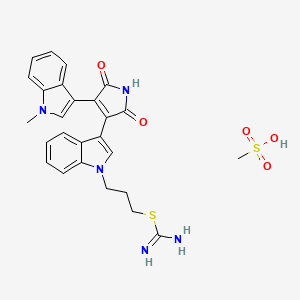
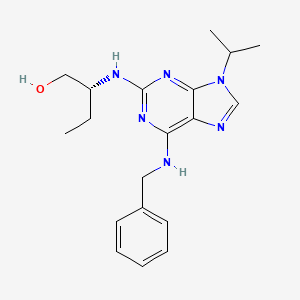
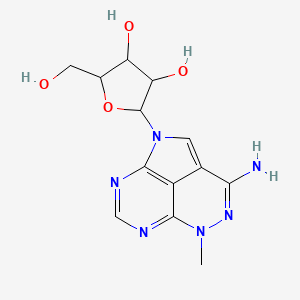
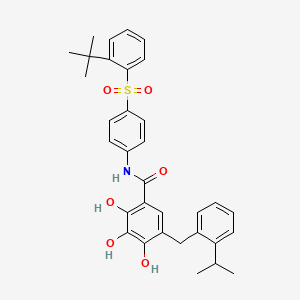
![[4-[(4,9-Dioxobenzo[f][1,3]benzothiazol-2-yl)amino]phenyl] 2-(methoxycarbonylamino)-4-methylsulfanylbutanoate](/img/structure/B1683862.png)
